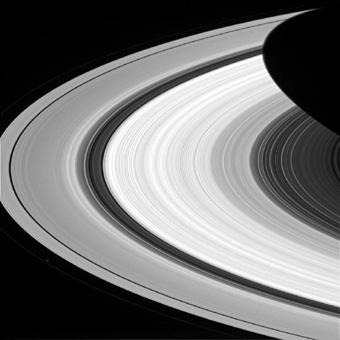
Rings of Saturn
| published March 17, 2015 |
By Thursday Review staff
No, this is not a black and white photo experiment with someone’s vinyl record. This is image is the work of Cassini, and a team of imaging experts in Boulder, Colorado.
In a stunning deep-focus image, a photo taken from the Cassini deep-space probe’s special wide angle lens using a red filter, Saturn’s ring system reveals itself to be far more complex than it appears from Earth, even when viewing the planet and its features using the best ground-based telescopes. This image was captured when Cassini was at a distance of about 566,000 miles (911,000 kilometers) from Saturn and shows the ring system at a 15 degree angle, with the sun’s light at a phase angle of 37 degrees. The photo’s resolution is about 34 square miles per pixel.
Thanks to images like this one, we learn that Saturn’s rings are made up of thousands of variations and concentrations, and the overall structure is punctuated by gaps likely caused by a combination of Saturn’s satellites and other objects. Some of Saturn’s moons orbit outside the ring system—such as Prometheus, which is visible as the small object just to the lower left of the outermost pale ring. The oblong shadow in the upper right is being cast by the massive planet Saturn, which sits in the center of the immense light show.
Saturn is the sixth planet from the sun, and the second most massive (after Jupiter). Its elaborate ring system is made up of nine continuous, variably-dense rings, and three non-continuous arcs or partial rings, made up mostly of ice crystals and dust. Among its various moons—and depending on how scientists and astronomers define each object, Saturn has some 60 distinct satellites—is Titan, a moon so large it exceeds the planet Mercury in size, and may be the only moon in our solar system so massive and complex on its surface that it maintains its own atmosphere.
Prometheus, that tiny dot of light in the lower left, is an irregularly-shaped object which—many astronomers believe—acts as a shepherd, keeping the inner and outer edges of the adjacent rings constrained, using its gravity to pull smaller material away, and clearing the path of loose material.
Cassini is a joint project of NASA, the European Space Agency, and the Italian Space Agency, but the mission is managed by the Jet Propulsion Laboratory in Pasadena, California.
Related Thursday Review articles:
The View From Above; Thursday Review staff; Thursday Review; March 3, 2015.
Photo Perfect Landing; Thursday Review staff; Thursday Review; March 12, 2015.
